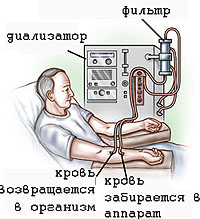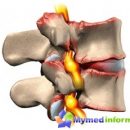Hemodialysis is most often used in renal failure - when the kidneys cease to function and remove the spent substances from the body. Dialysis - the success of medicine. How does this happen?
Content
Hemodialysis is most often used in renal failure – when the kidneys cease to function and remove the spent substances from the body. Hemodialysis cannot fully replace the kidneys, but with the help of this method, people can live normally and work, despite renal failure. Sometimes dialysis apparatus called «Artificial kidney».
During hemodialysis
 During hemodialysis, the patient's blood passes through the filter (dialyzer). The filter removes spent substances from the blood, excess liquid and salt
During hemodialysis, the patient's blood passes through the filter (dialyzer). The filter removes spent substances from the blood, excess liquid and salt
Before starting the procedure of dialysis, a doctor or nurse measure weight, blood pressure, pulse and temperature.
Then they put two catheters (conductor connecting the dialyzer and humans) – Usually one is placed in the artery, and the other in Vienna, therefore, the blood system «Connect» to a dialysis apparatus.
Staging catheters (if they were not installed in advance) – The only painful part of the procedure, but some may experience nausea and spasms in the abdomen during dialysis – This comes from the fact that a large amount of fluid is displayed at the same time. During dialysis, a person is headed in a special chair.
After the procedure is completed, the nurse will remove catheters from the veins and will impose a gulling bandage to this place to prevent bleeding.









